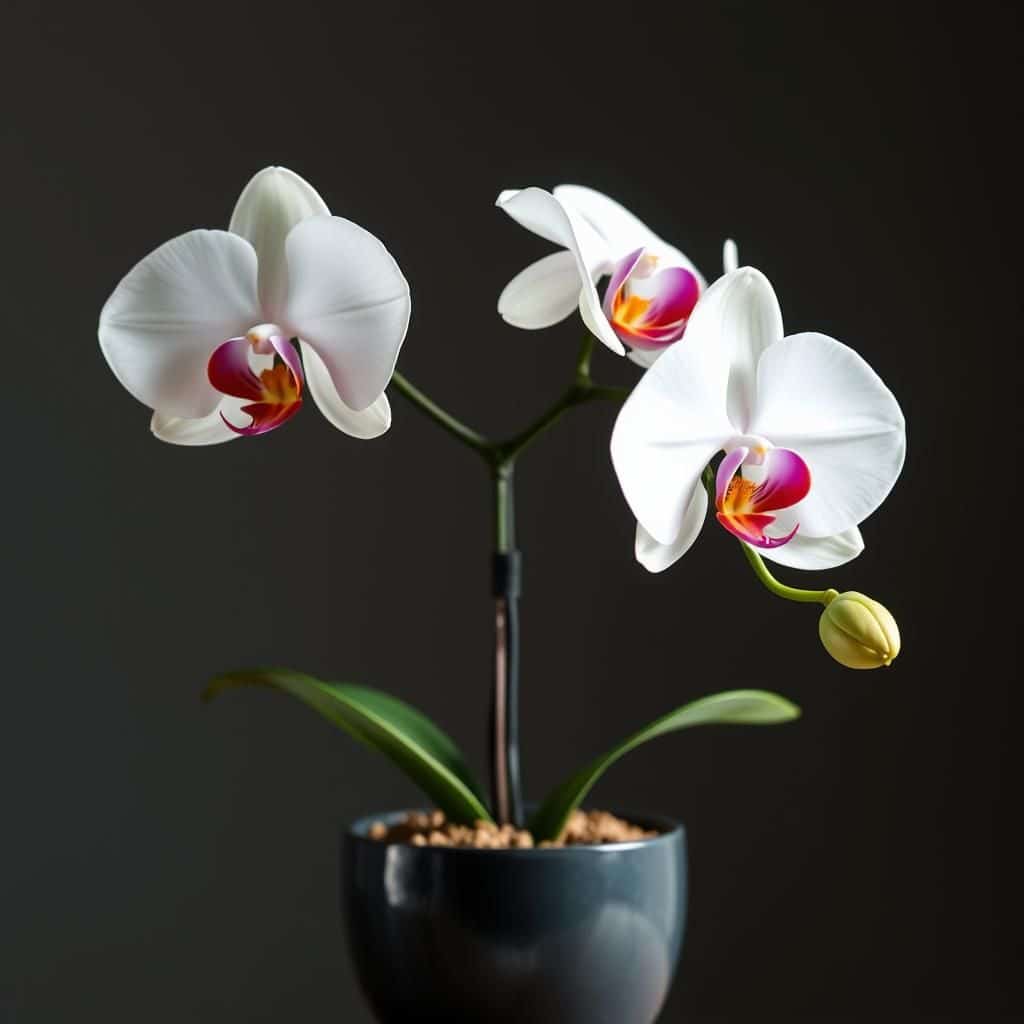Care Tips for the Beautiful White Phalaenopsis Orchid Plant: A Complete Guide

The Phalaenopsis orchid, commonly known as the moth orchid, is celebrated for its stunning white blooms and elegant appearance. This popular houseplant not only adds a touch of sophistication to any space but also symbolizes beauty and strength. Caring for a white Phalaenopsis orchid can be a rewarding experience, but it requires specific knowledge and attention to detail to thrive. In this complete guide, we will explore essential care tips, from watering and fertilization to light requirements and pest management. Whether you're a novice or an experienced orchid enthusiast, this article will help you keep your beautiful Phalaenopsis orchid healthy and vibrant.
Understanding the White Phalaenopsis Orchid Plant
The white Phalaenopsis orchid, commonly known as the moth orchid, is one of the most popular and sought-after orchid species due to its stunning appearance and ease of care. This plant features large, elegant blooms that come in a pure white color, making it a favorite choice for both indoor décor and special occasions. The white petals often have a slight sheen, creating a striking contrast against the plant's lush, broad green leaves. For those new to orchid cultivation, the white Phalaenopsis is an excellent starting point due to its hardy nature, ability to thrive under various lighting conditions, and resilience in the face of common pests. With proper care, this orchid can produce beautiful flowers multiple times a year, making it a long-lasting addition to any home or garden.
Care Requirements for White Phalaenopsis Orchids
Caring for a white Phalaenopsis orchid involves understanding its specific needs, including light, water, and humidity levels. These orchids prefer bright, indirect light, which is essential for healthy growth and blooming. Watering should be done every 1-2 weeks, allowing the potting medium to dry out slightly between waterings to prevent root rot. Additionally, maintaining humidity levels around 50-70% can enhance growth and flowering. Using a balanced fertilizer every few weeks during the growing season helps provide necessary nutrients. With these conditions met, your orchid can thrive beautifully.
Common Pests and Diseases
While white Phalaenopsis orchids are relatively resilient, they can still fall victim to common pests such as aphids, mealybugs, and spider mites. These pests can cause damage by feeding on the plant's sap, leading to weak growth and discoloration of leaves. It's important to regularly check the leaves and roots for any signs of infestation. If detected, natural remedies like insecticidal soap or neem oil can effectively manage these pests. Fungal and bacterial diseases can also occur, usually due to improper watering or high humidity, and can be treated by improving air circulation and using appropriate fungicides.
Reblooming Your White Phalaenopsis Orchid
Encouraging a white Phalaenopsis orchid to rebloom requires understanding its growth cycle. After the initial flowering period, it is essential to prune the flower spike when it turns brown. To promote a second bloom, consider reducing watering for a short period and providing a cooler nighttime temperature; this mimics the plant's natural environmental changes. Fertilizing with a high-phosphorus orchid food can also aid in triggering new flower spikes. With patience and proper care, it is quite common for Phalaenopsis orchids to produce new blooms multiple times a year.
See also:
Propagation Techniques for White Phalaenopsis Orchids
Propagation of the white Phalaenopsis orchid can be an exciting process, although it typically requires some expertise. The most common methods are by division or keiki propagation. Division involves carefully separating a mature plant into sections, each with roots and at least one growth. Keiki, which means baby in Hawaiian, refers to offshoots that grow on the flower spike and can be removed and potted separately once they have developed roots. Both methods can result in healthy new plants if done correctly, providing gardeners with the opportunity to expand their orchid collections.
Choosing the Right Potting Medium
Selecting the right potting medium is crucial for the health of your white Phalaenopsis orchid. These orchids thrive in a well-draining mixture typically composed of bark, sphagnum moss, or a commercial orchid mix. The purpose of this medium is to retain moisture while ensuring adequate air circulation around the roots, which is essential for healthy growth. Avoid soil that retains too much water, as this can lead to root rot. Repotting is generally recommended every 1-2 years or when the medium starts to break down, ensuring that your orchid has the best environment to flourish.
| Feature | Description |
|---|---|
| Light | Bright, indirect light is best for optimal growth. |
| Watering | Water every 1-2 weeks, allowing the medium to slightly dry out. |
| Humidity | Maintain humidity levels of 50-70% for optimal health. |
| Pests | Aphids, mealybugs, and spider mites are common concerns. |
| Propagation | Can be propagated by division or by removing keikis. |
Essential Care Practices for Thriving Phalaenopsis Orchids
To ensure your white Phalaenopsis orchid flourishes, it's vital to pay attention to a few essential care practices. Start by providing them with indirect light, as too much direct sunlight can scorch the leaves. Keep their environment humid, ideally between 40-60%, and consider using a humidity tray or a room humidifier. Water your orchid thoroughly, allowing the top inch of the medium to dry out between watering sessions. Fertilizing with a balanced orchid fertilizer every 2-4 weeks during the growing season will also promote healthy growth and vibrant blooms. Lastly, avoid exposing the plant to drafts or extreme temperatures to maintain a stable climate for optimal development.
Light Requirements for Phalaenopsis Orchids
Providing the right lighting conditions is crucial for the health of your Phalaenopsis orchids. They thrive in bright, indirect light, so placing them near a window where they can receive filtered sunlight is ideal. Avoid direct sunlight, as it can lead to leaf burn and hinder their growth. If natural light is limited, consider using grow lights that mimic the sun's spectrum, ensuring your orchids receive adequate light without the risk of damage.
Watering Techniques for Optimal Growth
Proper watering techniques can significantly affect the well-being of your white Phalaenopsis orchid. Allow the water to drain completely from the pot to prevent root rot, which often occurs when the roots sit in stagnant water. Typically, water your orchid every 7-14 days, depending on the humidity and temperature of your environment. It's best to check the moisture level of the potting medium before watering; if the top inch feels dry, it’s time to water. Always ensure that any excess water is eliminated from the saucer underneath the pot.
See also:
Humidity and Temperature Preferences
Phalaenopsis orchids flourish in environments with high humidity and stable temperatures. Ideally, maintain humidity levels around 40-60%, as this ensures optimal growth and prevents issues like drying out or leaf drop. If your environment is too dry, consider misting the plants or placing a humidifier nearby. The ideal temperature range is between 65°F to 85°F (18°C to 29°C). Ensure that they are not exposed to cold drafts or fluctuating temperatures which can stress the plant.
Fertilization Strategies
To promote healthy foliage and prolific blooms, proper fertilization is key. Use a balanced orchid fertilizer, ideally one that is specifically formulated for orchids, at half-strength every 2-4 weeks during the growing season. This provides the necessary nutrients like nitrogen, phosphorus, and potassium that Phalaenopsis orchids need for growth. Reduce or halt fertilization during the dormant winter months when the plant is not actively growing.
Choosing the Right Potting Medium
Selecting the appropriate potting medium is crucial for your Phalaenopsis orchid’s health. These orchids typically prefer a well-draining mix that retains some moisture without becoming waterlogged. A blend of bark, sphagnum moss, and perlite can create an ideal environment, ensuring aeration for the roots. Regularly assess the potting medium, as it may decompose over time, necessitating repotting every couple of years to avoid root suffocation and promote healthy growth.
Questions from Our Readers
What are the ideal growing conditions for a white phalaenopsis orchid plant?
The ideal growing conditions for a white phalaenopsis orchid plant include bright indirect light, humid environments, and temperatures between 65°F to 75°F (18°C to 24°C). It's essential to avoid direct sunlight, which can scorch the leaves, while maintaining a humidity level of around 50-70% for optimal growth.
How often should I water my white phalaenopsis orchid plant?
You should water your white phalaenopsis orchid plant about once a week, allowing the potting medium to dry out slightly between waterings. Always check the roots and medium; if they feel dry, it’s time to water, but be careful not to overwater, as this can lead to root rot.
See also:
What kind of fertilizer is best for a white phalaenopsis orchid plant?
A balanced Orchid fertilizer (such as 30-10-10) is best for a white phalaenopsis orchid plant, and it should be applied approximately once a month during the growing season. Dilute the fertilizer to half strength to avoid over-fertilizing, which can harm the plant's roots.
How can I encourage blooming in my white phalaenopsis orchid plant?
To encourage blooming in your white phalaenopsis orchid plant, ensure it has a period of cooler temperatures at night, typically around 60°F (15°C), as this can trigger flowering. Additionally, maintain consistent watering and feeding while avoiding stress factors like sudden temperature changes or pests.

If you want to read more articles like Care Tips for the Beautiful White Phalaenopsis Orchid Plant: A Complete Guide, we recommend you check out our Pots category.
Leave a Reply
Related Articles